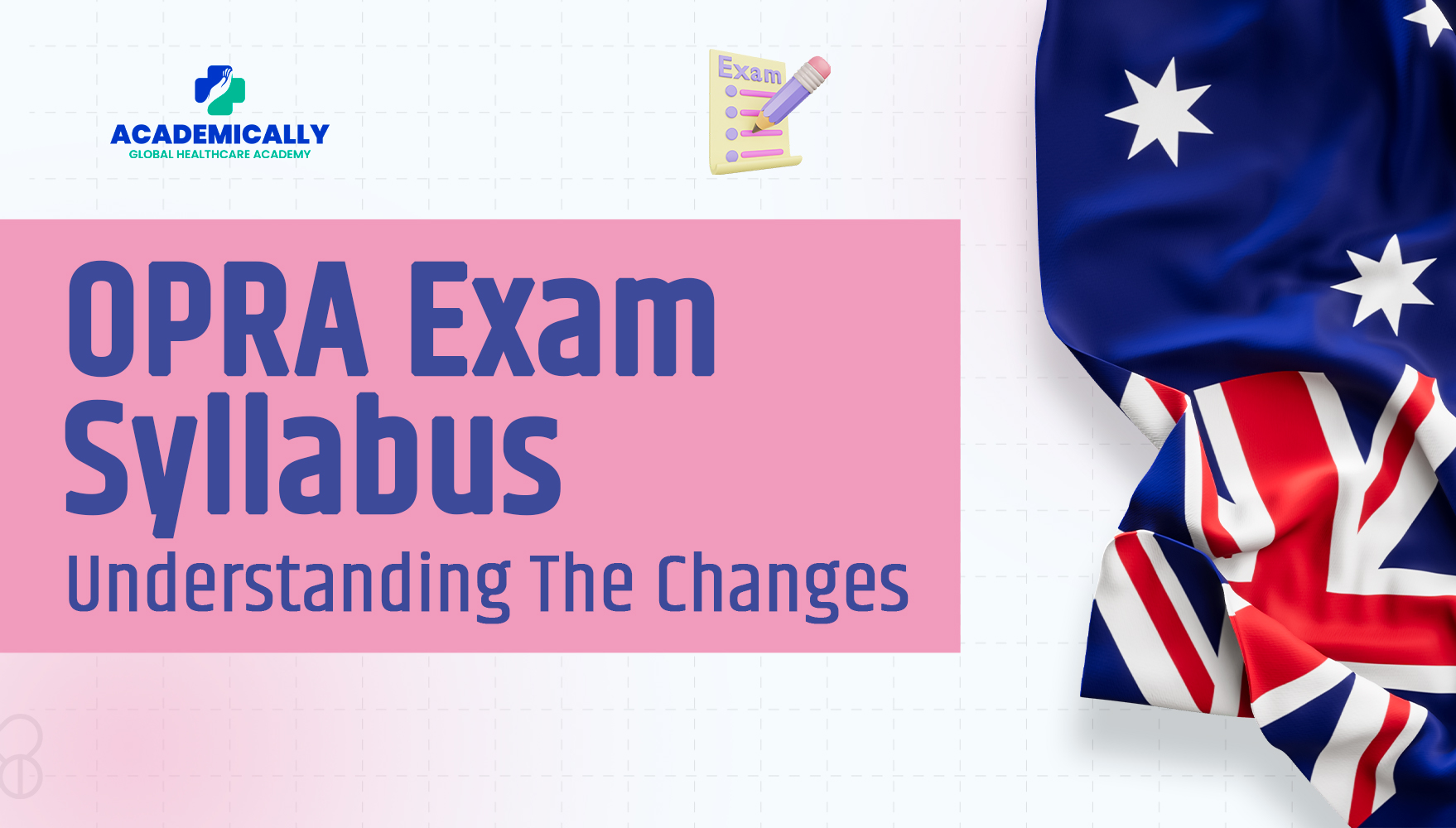Key Changes in the OPRA Exam Syllabus
While the OPRA exam content remains similar to the KAPS, there is a greater focus on therapeutics and the practical application of knowledge. This shift reflects the evolving role of pharmacists in Australia, emphasising their critical role in patient care and medication management. The updated syllabus aims to provide a contemporary and comprehensive assessment of your knowledge and skills, ensuring you are well-prepared for your internship and future practice.
Also Check: OPRA Exam Preparation Course
OPRA Exam Syllabus
OPRA Exam consists of five major content areas:
Content area | Percentage of questions allocated |
| Biomedical sciences | 20% |
| Medicinal chemistry and biopharmaceutics | 10% |
| Pharmacokinetics and pharmacodynamics | 10% |
| Pharmacology and toxicology | 15% |
| Therapeutics and patient care | 45% |
Biomedical Sciences
Biomedical sciences deal with normal and abnormal body functions, including cellular processes, and how diseases and disorders impact these functions. This encompasses the causes (aetiology) of diseases and disorders and the identification of normal and abnormal body functions.
| Content assessed | Topics |
| Physiological processes and normal bodily function for all systems | Central nervous, digestive, cardiovascular, lymphatic, nervous, respiratory, urinary, endocrine, and reproductive systems, and their integration; blood and other body fluids. |
| Pathophysiology | Alteration of normal physiological processes and genesis of disease states by genetic factors, environmental, chemical/drug causes, physical injury, infectious agents or other causes. |
| Medical Microbiology | Pathogenesis of infections (bacteria, viruses, fungi, and other parasites). |
| Immunology | Immune responses and defence mechanisms against infectious agents. Vaccines and vaccine-preventable disease. |
| Disorders affecting bodily fluids | Fluid and electrolyte disorders, metabolic acid-base disorders, and blood disorders. |
| Symptoms and physiological values of disease states and disorders | Signs, symptoms, of disease, diagnostic tests and laboratory investigations associated with normal and abnormal body functions, disease states, and disorders. |
Medicinal Chemistry and Biopharmaceutics
Medicinal chemistry and biopharmaceutics deal with the fundamentals of drug design and development, including the factors that influence or determine the materials and methods used in medicine formulation.
| Content assessed | Topics |
| Physicochemical properties of drugs | Physicochemical properties of drugs of relevance to drug absorption, distribution, metabolism, and excretion (ADME). |
| Formulations for the delivery of drugs | Properties of solids, solid dosage forms, solvents, solutes, solutions, aqueous and non-aqueous solutions, liquid-liquid solutions, solid-liquid solutions, gas-liquid solutions, suspensions, and emulsions. |
| Drug and chemical stability | Mechanisms of degradation (hydrolysis, oxidation), zero and first-order degradation, the effect of temperature and pH. |
| Solubility | Factors affecting solubility, dissolution, partition, and thermodynamics of pharmaceutical solutions. |
| Drug formulation | Materials and methods used in the formulation of drug delivery systems for common routes of administration, including oral, pulmonary, transdermal, parenteral, ophthalmic, nasal, rectal, and vaginal. |
| Pharmaceutical Microbiology | Preservation, antimicrobial agents, and sterilisation processes. |
Pharmacokinetics and Pharmacodynamics
Pharmacokinetics and Pharmacodynamics deal with factors that affect the absorption, distribution, metabolism, and elimination (ADME) of medicines from the body, along with how pathophysiological changes influence ADME and the choice of treatment options.
| Content assessed | Topics |
| Drug metabolism | Chemical and biochemical basis for drug action and pathways for drug metabolism, drug absorption, disposition, biotransformation, elimination, receptor theory, signal transduction mechanisms, and molecular pharmacology. |
| Principles of pharmacokinetics | Bioavailability and bioequivalence, biological half-life, elimination and clearance concepts, distribution, protein binding, steady state considerations. |
| Factors affecting drug impacts | Determinants of drug onset, drug duration, and effect of factors such as disease/conditions and diet on absorption, distribution, metabolism, and excretion. |
| Evaluation of pharmacokinetic data | Kinetics of drug interactions, drug concentration vs time curves and interpretation of pharmacokinetics of low-therapeutic-index drugs. |
| Using pharmacokinetic data in treating patients | Use of pharmacokinetics to calculate, evaluate, and individualise drug therapy including monitoring and adjustment of doses in renal and hepatic dysfunction, loading does and time to reach steady state. |
Pharmacology and Toxicology
Pharmacology and toxicology deal with how medicines exert their effects on the body, how common chemicals and toxins act, and the identification and management of toxic and adverse effects.
| Content assessed | Topics |
| Impact of drugs on the body | Effects of drugs on organs and body systems, dose-response relationships, agonists, partial agonists, antagonists, enzyme inducers/substrates/inhibitors, genetic polymorphism, and clinical relevance. |
| Receptor theory | Drug receptor interactions, agonists/antagonists, dose-response curves, desensitisation, and super sensitivity. |
| Mechanisms of action of drugs | Mechanisms of action of various drug categories as they relate to organs and disease states. Including but not limited to central nervous system pharmacology, cardiovascular pharmacology, haemostasis and thrombosis, cancer chemotherapy, antihypertensives, drugs for dyslipidaemia. |
| Adverse drug reactions | Adverse drug reactions, side effects of medicines and management and mechanisms of drug-drug interactions. |
| Drug interactions | Drug-drug interactions, drug-receptor interactions, drug-receptor binding, enzyme-substrate relationships, hydrophilic and hydrophobic interactions. |
| Drug toxicity and treatment | Drug and chemical overdose and antidotes. Signs and symptoms of toxicity and mechanism of toxicity and its management. |
| Factors causing changes in the pharmacology and toxicity of drugs | Modulators of drug pharmacology and toxicity include pharmacologic factors (disposition, biotransformation, renal elimination), physiological factors (age, sex, genetics, pregnancy, etc), and pathophysiological factors (liver disease, renal dysfunction). |
Therapeutics and patient care
Therapeutics and patient care deal with the clinical application of content areas 1-4 in patient care, encompassing the principles of health promotion, disease prevention, quality use of medicines, selecting medicines for special populations, and providing medication information.
| Content assessed | Topics |
| Screening | Calculation of common patient assessment parameters such as body mass index (BMI) and creatinine clearance. |
| Dose calculations | Amount of drug, number of doses, dosing based on body weight/ body surface area/ age/or other pharmacokinetic parameters, ratio and proportion, percentage, stock solutions, dilution and concentration, alligation, electrolyte solutions (milliequivalents/milliosmoles), reconstitution, infusion flow rates, isotonicity. |
| Primary health care | Selection of appropriate management options for treating illness and maintaining health and identification of circumstances where non pharmacological treatment is more appropriate. |
| Safe and effective use of medicines in populations requiring extended consideration | Consideration for medicine use, precautions, and contraindications in special populations: the elderly, children less than 12 years of age, during pregnancy or while breastfeeding. |
| Safe and effective use of medicines | Monitoring and review of management options, including medicines use and promoting adherence to medicines. |
| Harm minimisation | Knowledge about strategies for minimising misuse and abuse of medicines at the patient and community level. |
| Health promotion and disease prevention | Knowledge about general approaches for health promotion and disease prevention. Measures for promoting wellness, proper use of nonpharmacological treatment options. |
| Confidentiality | Understanding of general principles about maintaining confidentiality and professionalism when providing medicines information and handling patient records. |
Preparation Tips
To prepare effectively for the OPRA exam:
- Study Materials: Use updated textbooks and resources aligned with the new syllabus.
- Practice Questions: Engage with practice exams and case studies to familiarise yourself with the new content focus.
- Courses: Consider enrolling in OPRA exam preparation courses designed for the OPRA exam.
Final Words
Understanding the OPRA exam syllabus is crucial for your success in the OPRA exam. Staying informed and preparing thoroughly for OPRA will help ensure you meet the updated requirements and are well-prepared for your career in Australian pharmacy practice.
For more information about the exam or the OPRA exam preparation course, fill out this form to get one-on-one counselling with the expert.





